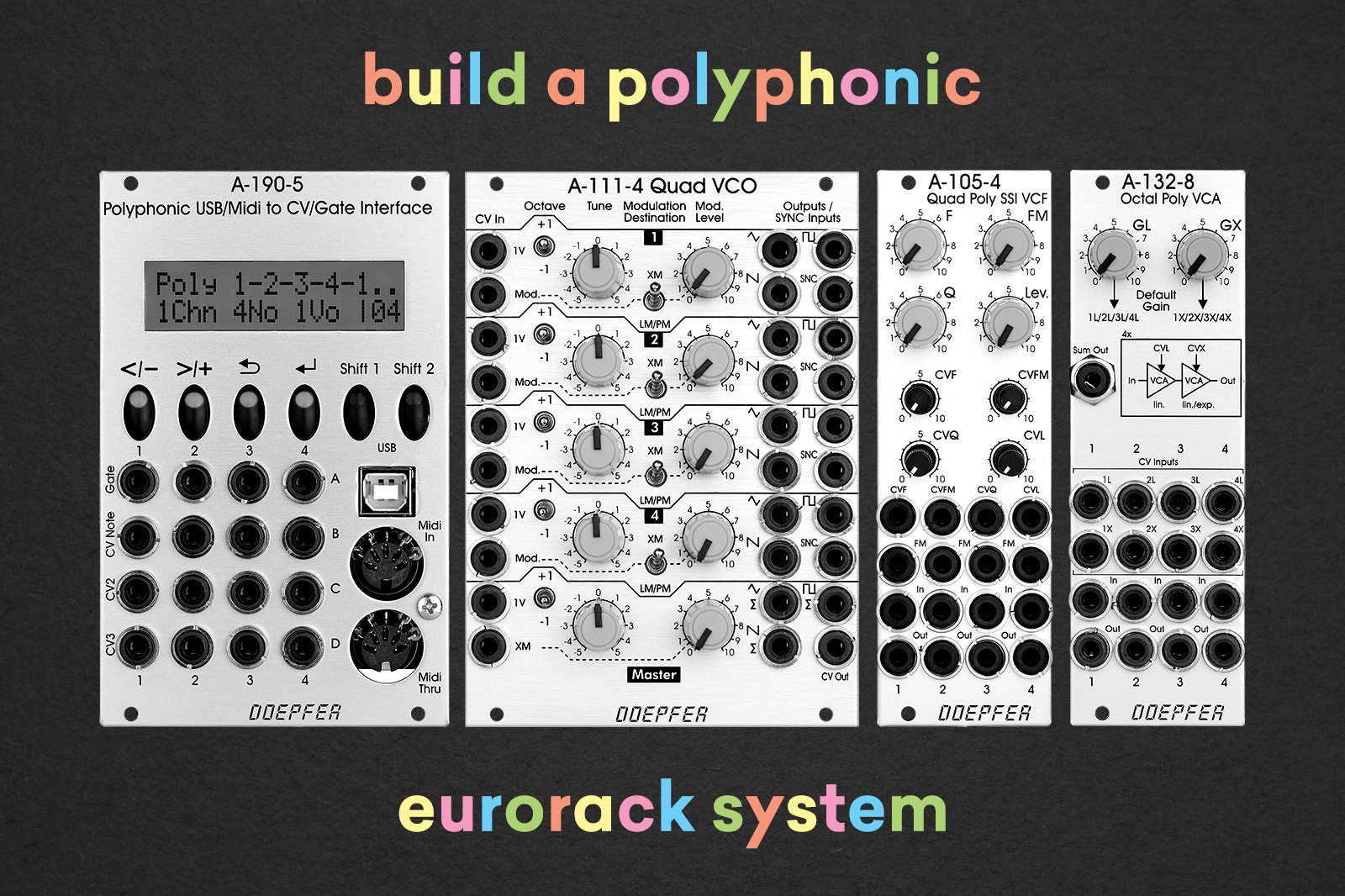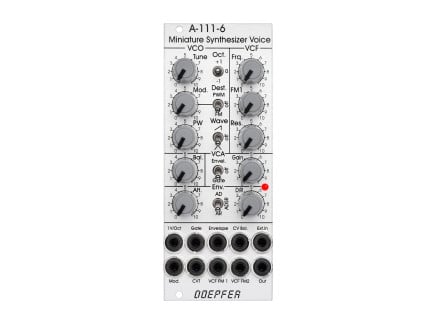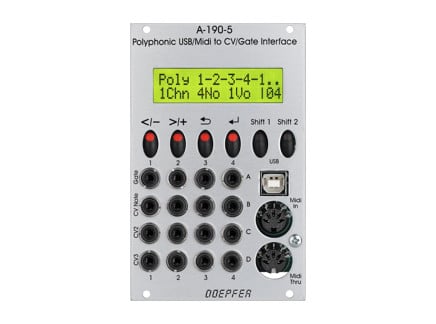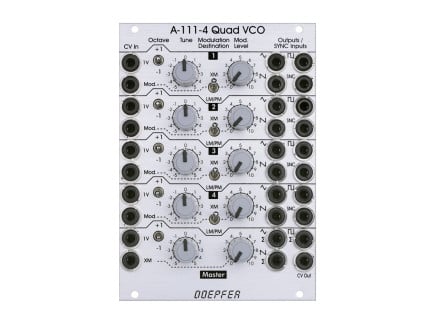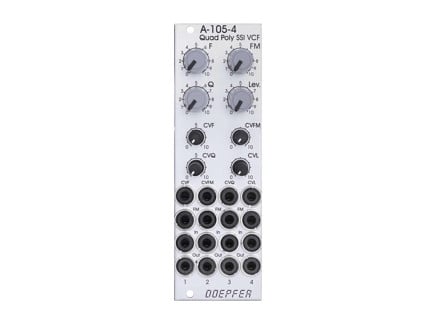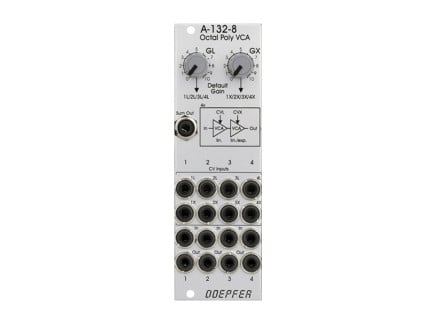Despite the ubiquity of polyphony in contemporary music, it continues to be both a technical and creative challenge within Eurorack systems. Doepfer’s polyphonic modules are a great option for artists looking for a way to access chordal or contrapuntal techniques with an analog signal chain.
While these modules work great together as a complete system or the core of a larger polyphonic rack, there are also many possibilities for extensions and substitutions within the Doepfer A-100 System. Modularity still gives the user the final say in how and whether to pursue a polyphonic or paraphonic instrument, and there are several different approaches to consider.
What is Polyphony, Anyway?
 A page from Musica enchiriadis (c. 900): one of the earliest written records of polyphonic music, in Daseian notation (an apparent imitation of ancient Greek notation by medieval scholars)
A page from Musica enchiriadis (c. 900): one of the earliest written records of polyphonic music, in Daseian notation (an apparent imitation of ancient Greek notation by medieval scholars)
Polyphony, the interplay of two or more simultaneous musical pitches or melodies, is a feature of many different music cultures, but the earliest known written record of polyphony is found in two anonymous music theory treatises from 9th century Europe, Musica enchiriadis and Scolica enchiriadis.
Early polyphony in European music consisted of singers doubling each other at the interval of an octave, fifth, or perfect fourth. (Think of it as a choral power chord.)
Later, composers started to experiment with multiple independent musical lines. Singers were no longer constrained to follow one rhythmic and melodic contour but rather sang in counterpoint. What we think of as classical harmony is believed to have arisen out of this contrapuntal polyphony.
The Challenge of Eurorack Polyphony
The ubiquity of polyphony in modern music, whether in chordal or contrapuntal form, has made it almost inseparable from our perception of music, often causing us to overlook its significance as a distinct compositional technique. However, when it comes to electronic music, particularly within the realm of hardware synthesizers, incorporating polyphony has presented challenges since the early days.
One of the main obstacles lies in the complex nature of the signal chain, which is responsible for shaping a raw audio signal into a vibrant and expressive "voice." Regardless of the synthesis technique used, the signal chain generally consists of various interconnected circuits and components, each serving a specific function in sculpting the sound. The introduction of polyphony requires the duplication of these individual parts to accommodate each new melodic voice within a composition.
Duplication of the signal chain poses technical and creative challenges. From a technical standpoint, adding multiples of components to handle additional voices can quickly lead to increased complexity and cost. Managing the routing, modulation, and control signals for each duplicated part becomes significantly more burdensome as the number of voices grows.
This challenge can be framed in terms of opportunity costs. While it is technically possible to duplicate oscillators, VCAs, filters, and other components for each additional melodic voice, most synthesists aspire to explore timbre as well as harmony. They want to explore the vast array of possibilities offered by digital and analog effects, intricate routing options such as switches and matrix mixers, and modulation and gating effects that shape a composition dynamically over time. Duplicating the necessary components for polyphony has practical implications, particularly in terms of space allocation. Accommodating multiple voices within a modular synthesizer system leaves less room for supporting modules that extend the compositional possibilities of Eurorack beyond what a simple polysynth can achieve.
[Editor's note: in modern modular synthesizers, there are many options for exploring polyphony, each with their own internal logic and distinct set of pros and cons. For more background on this topic, we recommend checking out our full three-part series on synthesizer polyphony: Synthesizer Polyphony—What Does It Mean?, Polyphonic Modular Synth: Classic Approaches, and finally, Polyphonic Modular Synth: Modern Approaches. In the remainder of this article, we'll expand on a subset of the techniques discussed in our article about classic approaches to modular polyphony.]
The à la Carte Approach
Prior to the availability of dedicated polyphonic modules, polyphony in Eurorack was often achieved simply by acquiring multiples of each module in the signal chain. This approach still has advantages for artists who require ultimate control over each voice. Despite a significant investment in terms of both cost and rack space, larger dedicated modules often allow more control than compact modules designed specifically for polyphony. This approach also provides the freedom to individually select and manipulate each module, enabling intricate modulation possibilities that would otherwise be unattainable.
The Complete Voice Approach
On the other end of the spectrum, some artists prefer to achieve polyphony through the use of full-voice modules. Although this approach makes the system less modular by relying on semi-modular components, it’s possible to reduce the complexity of a polyphonic system by structuring it around multiple modules that combine an entire signal chain internally.
Doepfer makes two full-voice modules. The A-111-5 and A-111-6 modules offer a range of synthesis capabilities in compact sizes of 24hp and 10hp, respectively. They share common features such as an oscillator, filter, VCA, and envelope, with internal normalling to simplify patching. However, the A-111-5 module goes a step further by including two LFOs, with one of them capable of being used for external output. These modules excel in providing a comprehensive set of functions within a limited space. It is important to note that due to their integrated design, the signal chain of these modules is not easily customizable. Furthermore, to synchronize modulation across multiple voices would require additional modules for synchronizing modulation as there is no built-in combined modulation bus for simultaneous control of all voices.
A Hybrid Approach: The Polyphonic Doepfer System
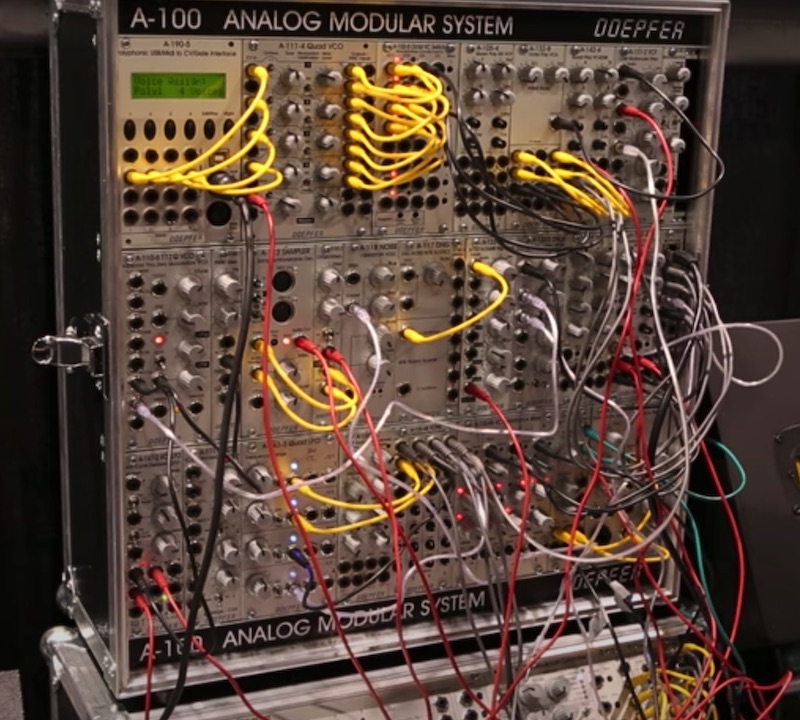 A polyphonic Doepfer system, from NAMM 2018
A polyphonic Doepfer system, from NAMM 2018
Somewhere between the á la carte and full voice approach, Doepfer’s polyphonic modules offer a compact polyphonic and modular solution with a patchable signal chain that still easily accommodates experimentation. First introduced at NAMM 2018, the Doepfer polyphonic system solves many of the challenges of constructing a polyphonic Eurorack by combining multiples of a single function within a compact module. For example, the A-111-4 is four voltage-controlled oscillators in 18hp; the A-105-4 is a four 24dB lowpass filter in 8hp; the A-141-4 contains four voltage-controlled ADSR envelopes in 8hp, and so on.
By grouping multiples of a function within each module, the Doepfer polyphonic line remains imitative of a single familiar signal chain. You can patch your oscillator to your filter and then on to your VCA just as you would with any subtractive synth. The main difference is you’re patching four cables into and out of each module (plus possible modulation) rather than just one.
Originally composed of five modules that provide a four-voice subtractive polyphony, Doepfer’s A-100 system now includes numerous modules with dual, quad, and octal functionality that could be added to extend the basic polyphonic system. Let’s look at the core modules, with some honorable mentions along the way.
Key Modules in Doepfer's Polyphonic Lineup
MIDI to CV: Doepfer A-190-5
The “brain” of the system, the Doepfer A-190-5 is a polyphonic MIDI/USB to CV/Gate interface. It allows users to MIDI-control up to four independent voices. Each voice has pitch control voltage (CVNote), gate outputs, and two additional control voltage outputs (CV2 and CV3) for modulation. The module offers various operating modes, including monophonic, unison, and polyphonic configurations, and provides parameter control for retrigger options, MIDI channel selection, and reference note settings. It features input/output options such as USB and MIDI DIN ports, as well as a memory function for storing and recalling settings.
Overall, the A-190-5 module acts as a powerful interface specifically geared to the needs of the polyphonic system. It provides the necessary control and coordination to unlock the expressive potential of multiple voices, turning a modular synthesizer into a versatile and dynamic instrument capable of creating intricate musical compositions.
Oscillators: Doepfer A-111-4
An unusual four-core analog oscillator, the Doepfer A-111-4 VCO boasts an impressive frequency range spanning approximately 10 octaves and offers four waveforms for each voice: pulse, sawtooth, triangle, and sine. One of the standout features of the A-111 VCO is its comprehensive modulation capabilities. It supports both exponential and linear frequency modulation, allowing for intricate and dynamic control over your sounds.
Furthermore, the A-111-4 provides options for hard and soft synchronization. Hard sync locks the waveform of one VCO to another, resulting in rich harmonic sidebands and unique timbral variations. On the other hand, soft sync maintains the waveform's integrity while establishing perfect harmonic relationships between multiple oscillators.
Modulation: Doepfer A-141-4 and A-143-4
The A-141-4 is a quad voltage-controlled envelope generator designed specifically for polyphonic applications. It features four ADSR envelope generators with built-in exponential curves. Each envelope generator includes a gate input, control LED, and envelope output, making it versatile for various synthesis techniques. The module offers manual controls for attack, decay, sustain, and release, as well as CV inputs with polarizers that modify the effect of the corresponding control input.
The envelope outputs span a voltage range of 0-10V, while the time range for Attack, Decay, and Release is adjustable from 1ms to 30s. The gate inputs require a minimum level of +5V and a maximum level of +12V, suitable for signals with fast rising slopes like rectangular waves.
The A-141-4 quad envelope generator provides simultaneous control over all four polyphonic envelopes through voltage control of each envelope stage. This means that you can replicate the same envelope across multiple voices, resulting in a powerful and efficient setup. However, it's important to note that if you require individual control of each envelope on a per-voice basis, additional modules would be necessary.
While the A-141-4 is an excellent polyphonic envelope, it’s worth considering adding an additional quad LFO to your polyphonic system for additional modulation. Still going strong after nearly two decades, the A-143-4 makes the perfect LFO for a polyphonic Doepfer setup. Despite being overshadowed by newer offerings, the A-143-4 from Doepfer remains a beloved module with a devoted user base.
Unlike the A141-4, the A-143-4 was not originally designed for polyphonic patching, but its quad design makes it an excellent modulation source for polyphonic instruments. Featuring four independent voltage controlled LFOs/VCOs with triangle core, each with two frequency control CV inputs, manual frequency control, and triangle/rectangle outputs, the A-143-4 offers interesting modulation possibilities. The common control section with CV inputs and manual control affects the frequency of all four units, and sum outputs provide access to combined triangle and rectangle waveforms drawn from all four cores. An optional ultra-low frequency mode allows negative control voltage applied to CV2 to pull the LFO rate down to periods of up to one hour!
Filters: Doepfer A-105-4
Designed specifically for polyphonic application, this compact powerhouse is Doepfer's first quad-core lowpass filter featuring four identical 24dB lowpass filters. Each filter has its own separate FM input, audio input, and audio output. The FM knob and CV FM input control the envelope amount for all four filters using built-in VCAs, giving you voltage control over the envelope amounts.
But that's not all; you can also apply common frequency modulation to all four filters simultaneously using the CVF input. The audio input level control is designed to to provide rich analog clipping and distortion at high amplitudes. Perfect for polyphonic patches or any setup where multiple controllable filters are needed (think stereo or quadraphonic applications), the A-105-4 packs a lot more than meets the eye in just 8hp. Just remember, due to the tolerances of the VCA amplifiers, the modulation depth and audio levels may vary slightly between the filters similarly to the natural variances between musicians playing together in an ensemble.
VCAs: Doepfer A-132-8
Although Doepfer makes several VCAs with polyphonic potential, including the A-135-1, A-135-2, and A-132-4, the A-132-8 Octal Poly VCA stands out as one of the coolest VCAs on the market. What makes it such a stand-out module is its unique quad/octal design. Each of its four channels feature a clean exponential VCA in series with a second linear VCA for a total of eight VCAs in just 8hp!
Because the human ear perceives loudness roughly along a logarithmic rather than linear scale, thresholds of perception tend to occur with a doubling of sound intensity rather than from a linear change in intensity. For this reason VCAs with an exponential response are sometimes preferred for audio envelopes while linear VCAs may be preferred for velocity or CV. The A-132-8 allows either or both of these options through clever normalling.
When no patch cable is inserted into a VCA's CV input, the internal default control voltage generated by either the linear or exponential stage is utilized, preventing signal loss even when one VCA in a chain remains unused. Once a patch cable is connected to a CV input socket, the external CV takes precedence in controlling the VCA level. This design makes the A-132-8 both the perfect polyphonic VCA as well as a pretty great utility VCA for just about any task.
Despite its density, the A-132-8 doesn’t sacrifice much in the way of features. An additional sum output allows the module to be used as an end-stage mixer, and knobs provide global gain control over linear and exponential VCA buses. Jumpers on the back also allow the A-132-8 to function as two linear VCAs in series (desirable when used with an exponential envelope such as the A-141-4, which typically negates the need for an additional exponential stage).
The Future Of the Doepfer Polyphonic System
While polyphony will continue to be challenging in the Eurorack format, Doepfer’s polyphonic system offers an excellent balance between size, features, and usability within an analog signal chain. Through other multi-core Doepfer modules such as the A-150-8 octal switch and the A-149-4 Polyphonic Random Voltage Source, the system can also be expanded to accommodate more complex patching.
Notably, Doepfer continues to invest in the future of their polyphonic system, evident in their latest offerings showcased at Superbooth 2023. The A-135-5, a forthcoming voltage-controlled mixer and suboctave generator, and the A-171-4, a quad voltage-controlled slew limiter, demonstrate the brand's commitment to innovation and further enhancing the polyphonic experience. This commitment ensures that Doepfer's polyphonic system will remain a compelling choice for musicians and artists who not only seek to overcome the challenges imposed by hardware but also position this challenge as a catalyst for inspiration.

